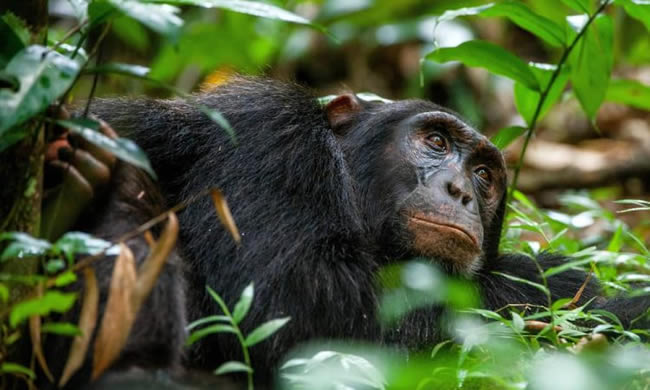Kibale National Park is situated in Uganda’s western region, about 26 kilometers out of Fort Portal town. It generally makes up of one of East Africa’s oldest moist rainforests, Kibale Forest. The Park sits on an area of 296 square kilometers, initially gazetted as a forest reserve in 1932 and later transformed into a national park in 1993. This was meant to streamline conservation activities given the incredible populations of wildlife and flora therein, and make way for the formal launch of extensive ecotourism.
Chimpanzee trekking and habituation tours in Kibale Forest.

Kibale National Park is Uganda’s central hub of chimpanzee trekking, claiming the highest number of chimpanzees in single location. Chimpanzees in Kibale forest are estimated to be about 1,500 in number. This otherwise means that a visitor has all expectations of viewing chimpanzees than anywhere else.
Chimpanzees are interesting primates having close similarity with human beings. They live in troops (groupings) in which they breed and interact. Trekking is the main activity around these creatures, although habituation has progressed with some troops and this makes habituation another activity around these primates. The beauty with habituation is that tourists get more time with chimpanzees compared to trekking.
How is chimpanzee trekking done?
To begin with, for one to trek chimpanzees in Kibale National Park, they are required to have a trekking permit. These are purchased from Uganda Wildlife Authority offices or through an indigenous tour company. This is the access document into Kibale National Park. Chimpanzee trekking is carried out in two shifts daily, first one beginning at 8:00am and the second shift in afternoon at about 2:00pm. Before trekkers set off for any of the two shifts, they are first undertaken through a briefing at park headquarters.
The purpose of this briefing session is to make sure trekkers understand the rules that govern chimpanzee trekking adventure in their natural wilderness, before they are grouped (each group has a maximum of 8 trekkers) and assigned rangers for navigation and protection. Chimpanzee trekking tour goes on for 1 to 7 hours, depending on how fast the chimpanzee groups can be traced. As a precaution, the required age for any trekker is 15 years or above.
When to go for chimpanzee trekking?
Chimpanzee trekking and habituation is most favorable during dry seasons. The constant rains during wet seasons are so interruptive especially during the walks in natural wilderness. Therefore, trekkers are advised to take on the trekking tours in periods between early June and September, or from December to February. These are the best months to trek chimpanzees in Kibale Forest. The forest trails during dry seasons are dry and easy to navigate, rather than facing the mud. Additionally, the trekking trails are easy to navigate during the dry season.
How much does it cost?
The cost of chimpanzee trekking is fair considering the memorable experience visitors get. East Africa nationals pay UGX 150,000/= for each trekker; Foreign residents pay $150 for each trekker; while the foreign non-residents pay $200 per person.
Other activities in Kibale National Park.
- Nature walks.
Nature walks are often desired by two types of visitors i.e., birders, and botanists. Both groups get a fulfilling time while in the wilderness. Birders get to view hundreds of bird species while the botanists also get quality time viewing and studying the thousands of plant species in the interrupted lush areas of the park.
The trails within Kibale national park also give considerable hours for trekkers which commence in the morning hours at Kanyanchu Visitors’ Centre. These trails can go on to about 12 kilometers.
- Crater lake tours.

These were formed due to volcanic activities that took place in the region thousands of years ago. Most are situated in Kabarole district. The beauty with this is that they can all be accessed on foot since locating them is easier and ground is well laid for exploration. There’s some hiking included to access the higher points that give off a good scenery of most parts of these crater lakes. Besides viewing the lakes, higher points also create moderately detailed views of Mountain Rwenzori, Lake Gear, the Kibale forest and Kichwamba escarpments that form part of the western arm of East Africa rift valley.
There are over 50 small lakes that make up Ndali – Kasenda Crater lakes region. While at Kabata village, a village that’s in the vicinity of Kasenda Crater lakes, tourists get an opportunity to visit Mahoma falls, which are amazing landforms. Kabata village has over 12 crater lakes, most famous ones which include Rukwanzi, Nyinambuga, and Lyantonde crater lakes.
- Birding.
There are hundreds of birds that live and breed within Kibale Forest. Most of these however, are forest birds and can be viewed flying under and above the giant tropical trees. Their chattering is also a thing that visitors can’t get tired of besides the chants from primates.
Some of these include Forest Francolin, Yellow-throated Cuckoo, Ayres Hawk-Eagle, Red-billed Helmet Shrike, Western Bronze-napped Pigeon, Gabon Woodpecker, African Wattled Plover, Fan-tailed Widowbird, and many more.
- Community encounters.
These happen within Batooro communities, the dominant tribe around Kibale national park, and the minority Bakiga tribe. Their cultures are so unique and tourists find the two cultures fascinating, while they get an opportunity to explore different traditional lifestyles of the two tribe which include local foods, cultural songs and dances, folklore, art, and local crafts. Expeditions of the Tooro kingdom palace is also an interesting activity.
